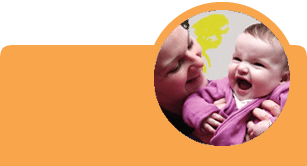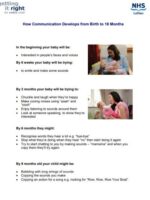
How Communication Develops from Birth to 18 Months
In the beginning your baby will be:
- interested in people’s faces and voices.
By 6 weeks your baby will be trying to:
- smile and make some sounds.
By 3 months your baby will be trying to:
- chuckle and laugh when they’re happy.
- make cooing noises using “aaah” and “oooh”.
- enjoy listening to sounds around them.
- look at someone speaking, to show they’re interested.
By 6 months they might:
- recognise words they hear a lot e.g. “bye-bye”.
- stop what they’re doing when they hear “no”, then start doing it again.
- try to start chatting to you by making sounds – “mamama” and when you copy them, they may try again.
By 9 months old your child might be:
- babbling with long strings of sounds.
- copying the sounds you make.
- copying an action for a song e.g. rocking for “Row, Row, Row Your Boat”.
When your child reaches their first birthday, they might be trying to:
- sing along with a song.
- shake their head to say “no”.
- understand their own name and some other words e.g. “cup” at snack time.
- point to tell you what they want.
It’s amazing, but by 18 months your toddler will probably try to:
- say a few words.
- look to people and objects when you name them.
- make some animal noises e.g. “moo” or “baa”.
- use a word or words when singing a song.
How You Can Help
Chat about your day using short phrases – “We’re going on a bus”, “Mummy’s putting the clothes away”.
Have some time every day for play:
- Switch off the TV and radio – so it’s quiet when you play.
- Look to see what your child is playing with and join in.
- Copy the sounds and words they say -then they know you are listening.
- Enjoy sharing a book with your child.
- Sing songs and rhymes together e.g. “Round and round the garden”.
Remember children develop at different rates. If you have any queries regarding your child’s development please speak to your Health Visitor or contact your local Speech and Language Therapy department here.





